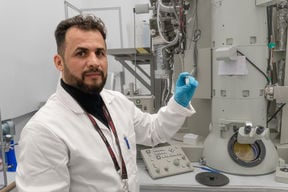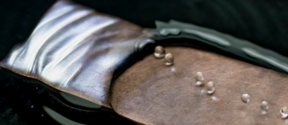Soft Matter and Wetting
Functional soft materials and wettability of surfaces are the key research interests of Soft Matter and Wetting research group at Aalto University Department of Applied Physics.

Aalto University Researcher Hedar Al-Terke seized the opportunity to shape his academic path when his supervisor encouraged him to get creative with his research project. This led Al-Terke to reflect on meaningful topics with the capacity for substantial impact.
‘Healthcare has always been a subject at the top of my mind. With the task of choosing a new research direction, I began exploring functional interfaces for medical applications,’ Al-Terke says.
Having emigrated from Iraq to Finland in 2005, Al-Terke was personally motivated to make necessary medical technologies more accessible for places like his home country. This was when injectable microbubbles for cancer diagnostics first piqued his interest.
It is characteristic of microbubbles to resonate strongly when scanned via ultrasound—making them appear bright white in the readout. But there is a catch: typical injectable microbubbles last less than ten minutes in the bloodstream, and there is no way to control their direction.
Smart Bubbles, the business project born out of Al-Terke’s research question, eliminates both problems. With a proprietary protein coating, Smart Bubbles extends the lifespan of microbubbles to an hour. Additionally, the bubbles have been made “smart,” so that they adhere themselves to cancer cells otherwise invisible to ultrasound.
The result is a minimally invasive and cost-efficient method to detect cancer early using technology already widely available throughout the world.
Al-Terke dons a brand-new lab coat and dashes between Aalto’s physics buildings as the first snowfall of the Finnish winter begins piling up.
Through meandering corridors, he enters a chamber housing OtaNano’s massive cryo-transmission electron microscope. This is where much of the initial testing of Smart Bubbles took place.
Procuring a handheld ultrasound device, he explains the differences between this technology and other common cancer imaging instruments.
‘In the case of MRI, we have good spatial resolution, but bad temporal resolution. Ultrasound is the opposite: bad spatial resolution but excellent temporal resolution,’ Al-Terke says. This means MRI’s strength is providing highly detailed images at one specific moment, while ultrasound is superior at showing how the scanned area appears over time.
‘With the Smart Bubbles innovation, we increase the spatial resolution of ultrasound, which is far cheaper to operate than MRI or CT machines,’ he says. ‘With this improvement, we have achieved an advantage over other cancer imaging devices at a fraction of the cost.’
Although air in the bloodstream can be cause for concern in some instances, microbubbles as an ultrasound contrast agent is a thoroughly tested area of medicine. Additionally, Smart Bubbles are manufactured in a sterile environment, and the bubbles themselves are smaller than red blood cells. The protein coating is edible, and any leftover waste is easily processed by the kidneys and liver.
Smart Bubbles developed their project with €800 000 in funding from Business Finland, and their next step is seeking out investors.

Hedar Al-Terke, Aalto University ResearcherWith this improvement, we have achieved an advantage over other cancer imaging devices at a fraction of the cost.
Al-Terke recalls a pivotal moment when he was a teaching assistant in an an integrated project course combining entrepreneurial training with engineering design taught by Lecturer Janne Halme. This ignited a mindset shift on his approach to research and entrepreneurship.
‘I realized I was in a position to solve real problems. There are others in this world who are not educated, who have had hard life circumstances,’ Al-Terke says. ‘Through identifying the problem first—in this case, the lack of accessibility of cancer diagnostic technologies—I was then able to craft a meaningful solution that has the chance to make a lasting global impact.
As part of the Business Finland funding requirements, Smart Bubbles' next step is to explore other business opportunities, such as initiating a company by the end of the project. Now that preclinical trials underway in collaboration with the University of Oulu, Al-Terke says the primary goal is to seek investor funding to begin clinical trials by 2025.
With eyes looking forward, Al-Terke says the Smart Bubbles platform could serve in applications that have yet to be tested, such as drug delivery modalities or for non-cancer purposes.
‘I arrived at this innovation due to my willingness to ask so-called stupid questions,’ Al-Terke said. ‘Through ongoing collaboration with my team, asking those probing questions could reveal wider-reaching applications of this technology.’
Al-Terke is part of the Soft Matter and Wetting research group, led by the Head of the Department of Applied Physics Robin Ras. The research group is part of the LIBER Center of Excellence. Al-Terke was awarded the department’s 2023 Physics Innovation of the Year Award for his Smart Bubbles project.
Other key collaborators in Al-Terke’s research include Aalto Professor Jaakko Timonen, VTT Research Team Leader Arja Paananen, VTT Principal Scientist Jussi Joensuu, and Postdoctoral Researcher Grégory Beaune. The Smart Bubbles research utilized equipment from OtaNano, Finland's national research infrastructure for micro-, nano-, and quantum technologies.

Functional soft materials and wettability of surfaces are the key research interests of Soft Matter and Wetting research group at Aalto University Department of Applied Physics.

LIBER aims to create dynamic and soft hybrid materials with a capability to learn, adapt or response to the environment. LIBER combines eight research groups with expertise on molecular self-assembly, soft robotics, surfaces and interfaces, genetic engineering of proteins, biotechnological production of engineered biomolecules, and computational modelling.

OtaNano is Finland's national research infrastructure for micro-, nano-, and quantum technologies



